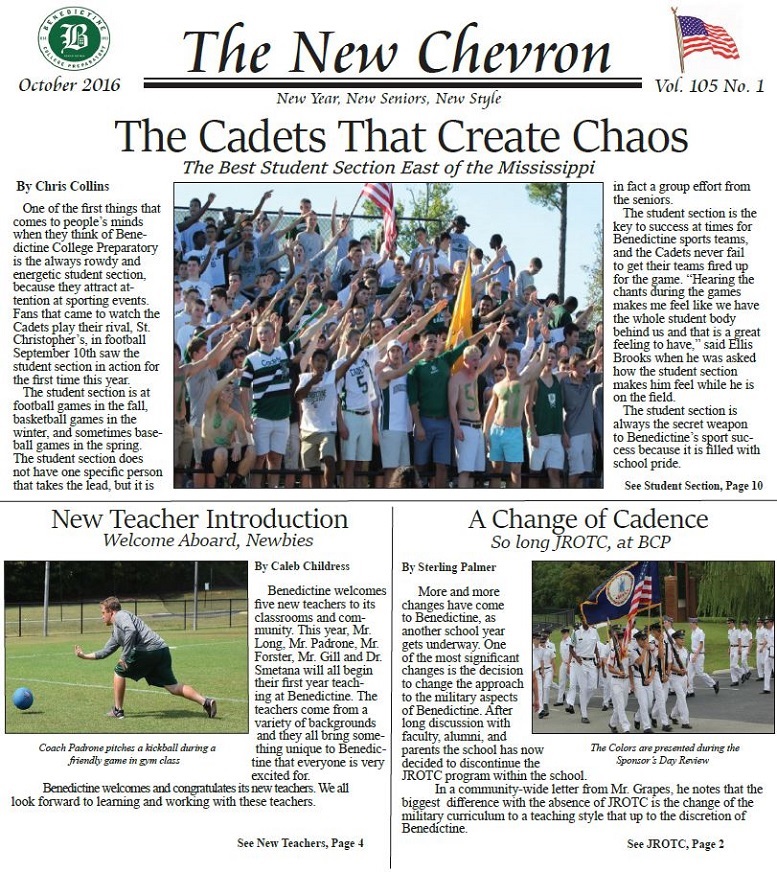Pat Elder | Counter-Recruit Press | November 2018
 The March 2010 edition of Richmond’s Benedictine College Preparatory student newspaper, The New Chevron, carried two articles on the Iraq War exploits of the school’s newly-hired headmaster, Jesse A. Grapes. During the 2nd Battle of Fallujah in November of 2004, 1st Lieutenant Grapes saved the lives of three Marines in his platoon. The newspaper reports:
The March 2010 edition of Richmond’s Benedictine College Preparatory student newspaper, The New Chevron, carried two articles on the Iraq War exploits of the school’s newly-hired headmaster, Jesse A. Grapes. During the 2nd Battle of Fallujah in November of 2004, 1st Lieutenant Grapes saved the lives of three Marines in his platoon. The newspaper reports:
Jesse A. Grapes, only three words can describe this man, patriotic war hero. He consistently showed unyielding bearing, fortitude, intuition, and courage while serving his country in war. The Marines who served under him said, “He is a hard-charging small unit tactician who literally wrote a book about modern urban warfare following his ferocious experience in Fallujah.”
1st Lieutenant Grapes led 3rd platoon into the chaos of Fallujah, in which he furthered his heroism with his actions of saving three wounded marines at the “infamous Hell House.” To accomplish this feat, he tore off his body armor, forced his body through a window of a burning house, which enabled him to encounter the enemy soldier who had been firing at his troops.
Following this act of heroism, he was accused of the capture, murder, and torture of several prisoners of war. To this he said, “I know nothing about the alleged capture or order to kill the prisoners. If I had heard such a thing I would have immediately stopped it.” Grapes also refused a polygraph examination saying that no machine can trump his honor. “If my word isn’t good enough, nothing would be.”
Grapes’ word was “good enough” to lead the Catholic military school.
Three Marines under the command of 1st Lt. Jesse Grapes shot four defenseless prisoners during the Battle of Fallujah. When the crime came to light a few years later, it made front-page news across the country as the first war crimes charges against service members prosecuted in federal (civilian) court. Naval Criminal Investigative Services, a federal grand jury, and court witnesses documented the events of November 9, 2004, in Fallujah. Grapes’ platoon had been taking fire from a house. After the troops entered the building and captured the insurgents, Sergeant Jose Nazario, Jr. used a radio to call for orders on what to do next.
This is according to the testimony of Marines Weemer, Nelson, and Prentice, who say they were in the room with Mr. Nazario at the time. The instructions, Mr. Nazario told them, were to kill the prisoners. “We argued about it, and argued about it, and we had to move, we had to get out, and our unit was moving down the street,” Mr. Weemer says in the transcript of his testimony.2
Weemer said he shot the insurgent twice in the chest and instantly felt remorseful.3 During the polygraph examination, Weemer alluded to similar atrocities that had occurred on other occasions, indicating his unit did not take prisoners.4
Nazario testified that he was asked over the radio, “Are they dead yet?” When Nazario responded that the captives were still alive, he was told by the Marine on the radio to “make it happen.”5
Prentice said Nazario exchanged radio messages with higher-ups. “Spartan Three, this is Spartan Three-Three,” Prentice claimed Nazario said over his radio. “We have four MAMs (Military-aged males), found AK47s in the house.” “Then Nazario says negative,” Prentice said. “Then Nazario says affirmative.”
Marine Corps records show that at Fallujah “Spartan Three” was 1st Lt. Jesse Grapes, the 3rd Platoon commander. Grapes was not called as a witness.6
Grapes told investigators he had no recollection of hearing about captured enemy combatants on his radio. He was discharged from the Marines after refusing to talk to government investigators about his role at Fallujah. He exercised his Fifth Amendment right against self-incrimination and also refused to testify at the Federal Grand Jury hearing.7
In the end, all criminal charges were dropped when the Marines refused to testify against each other or their commander. It’s quite a lesson for the students at Benedictine College Prep. The Benedictine website contains the following segment entitled “Why Catholic?” that quotes a selection from the Bible, 1 Peter 3:15,
Today, Benedictine College Preparatory continues to glorify God and mold young men into soldiers of Christ. In the world, these men will be ready to fulfill St. Peter’s command: ‘always be prepared to make a defense to anyone who calls you to account for the hope that is in you.’ ”8 Appearing in the same edition that welcomes the warfighter accused of murder as the new headmaster, this verse is taken out of context and is terribly misleading, bringing to mind the haunting biblical exhortation in Matthew 18:6: “Whoever causes one of these little ones who believe in me to sin, it would be better for him to have a great millstone fastened round his neck and to be drowned in the depth of the sea.”
Examine this verse in context in 1 Peter 3:13-16,
Now who is there to harm you if you are zealous for what is right? But even if you do suffer for righteousness’ sake, you will be blessed. Have no fear of them, nor be troubled, but in your hearts reverence Christ as Lord. Always be prepared to make a defense to anyone who calls you to account for the hope that is in you, yet do it with gentleness and reverence; and keep your conscience clear, so that, when you are abused, those who revile your good behavior in Christ may be put to shame.
This is a different message, and it reflects the true gospel message. The school also has an annual Boxing Smoker in coordination with the Georgetown University Boxing Team. Would Jesus have a front row seat?
Benedictine is a kind of poster child for the militarized Catholic school. Every year the school requires all juniors to take the military’s enlistment exam. The school operates an Army JROTC program and teaches small arms practice. Of course, these are expected activities in a military school. The question is whether these activities are appropriate in a Catholic school.
The National Catholic Reporter put it this way in 2003:
Long overdue in the American church is a reasoned and deep discussion of U.S. militarism, the proper use of force, the state’s responsibility to protect and defend, and the role of people of faith in all of this. To this point, Catholic teaching has had little effect in distinguishing us from any other segment of society when it comes to participation in wars and militarism.
The church has chosen to antagonize the state on issues related to abortion, homosexuality, and contraception, but this peripheral resistance provides a relatively minor irritation to the comfortable, contemporary church-state relationship. A rejection of war and violence, however, carries with it a repudiation of nationalism and patriotism, unthinkable in today’s church-state nexus.
The Benedictine website says the work of the school is to mold young men into soldiers of Christ. Did Jesus institute a militant faith?
Military recruiters typically don’t frequent Benedictine in search of enlisted men because schools like Benedictine do the work for them, in this case, providing the military with young men who become officers. Many Benedictine Cadets pursue their college education at the service academies or schools like VMI or the Citadel.
Catholics and the military share a tight bond. About 10% of all Catholic priests have a military background, and 20% grew up in military families. Three years ago every member of the Joint Chiefs except for Marine Corps Commandant Gen. John Amos was a practicing Catholic, according to the Archdiocese for Military Services. 9
Catholic high schools across the country encourage regular visits by military recruiters and sponsor dozens of military programs that entice youth to enlist, often without full disclosure of the true intent of the programs.
Catholics, including youth and priests, enlist in a military that requires the subordination of Catholic doctrine to the military command. For many students, the vestiges of 12 years of Catholic education are largely erased in a few weeks of basic training. Catholic high school
students who enlist take an oath that requires obedience to Army regulations, including the Army Field Manual, which states,
“Your personal values may and probably do extend beyond the Army values, to include such things as political, cultural, or religious beliefs. However, if you’re to be an Army leader and a person of integrity, these values must reinforce not contradict, Army values.” 10
Jesus said no one could serve two masters.
The U.S. Military Entrance Processing Command (USMEPCOM) is poised to exploit the dichotomy. For example, the 3rd Recruiting Brigade headquartered in Fort Knox, Kentucky encourages Catholic recruiters to request permission from school officials “to attend Mass in their dress uniform.” The Brigade says Catholic high schools would be honored to have recruiters join students at Mass and that attendance should improve relations with administrators.11
Catholic Schools have done a poor job, compared to many of their public school counterparts, in protecting children from the military’s predatory practices. In some cases, the recruiting command couldn’t be more effective than the Catholic command. For instance, hundreds of Chaminade Catholic High School graduates from Mineola, New York have entered military service upon graduating from the school. Sadly, 55 Chaminade graduates have been killed in combat, at least since the 1960’s.12
Like Chaminade, St. Pius X High School in Lincoln, Nebraska acts as a proxy for the Recruiting Command. In 2015 the school apparently required 247 students to take the military’s enlistment exam, known as the ASVAB or Armed Services Vocational Aptitude Battery, without providing for parental consent. The school sent test results, along with social security numbers and sensitive demographic information, to the Pentagon without parents specifically saying it was OK. Although military regulations clearly identify the testing regime as a recruiting device, few, if any Catholic schools notify parents of the true nature of the program.13
Catholic schools that receive funds under the Elementary and Secondary Education Act (ESEA) must provide military recruiters, upon request, the names, addresses and phone numbers of children. The law gives parents the right to “opt out” from lists including their children’s names being forwarded to the DoD by notifying the school of their intention. Often, Catholic school students or teachers receive services under ESEA programs, but the schools themselves do not receive any ESEA funds.14 Many schools release records nonetheless.
Catholic Schools are a notoriously independent bunch, unlike state and local schools operating under boards that may regulate hundreds of institutions. For instance, Maryland requires all parents to complete a form specifically asking if they want to remove their child’s name from
lists being sent to recruiters. Catholic schools have no supra-school authority like this (certainly not the National Catholic Education Association), and the military prefers it this way.
The law exempts private schools that maintain a religious objection to service in the Armed Forces. Although this applies to schools affiliated with traditional Christian peace churches like the Church of the Brethren, Quakers, or Mennonites, it does not apply to the military-friendly Catholic Schools.
Instead, schools like St. Louis Catholic High School in Lake Charles, LA apparently require parents to sign a form that releases directory information, along with transcripts, grade point averages, and class rankings to the recruiting command.15
In the 2009-2010 school year, one Milwaukee recruiter was able to use his 15-hour-per-week job as a volunteer coach to mentor—and eventually, enlist—five football players from Pius XI High School. Pope Pius XI, the “peace and justice pope” of the 1930s, would have been appalled.16
We’ve seen how the Army calls for school ownership, and it is apparent at Greensburg Central Catholic High School in Greensburg, Pennsylvania, where the U.S. Military Entrance Processing Command presents awards to recruiters and holds regular change of command ceremonies.17
Recruiters are intent on getting inside the heads of all high school students, including Catholic school students. During the 2012-2013 school year, the military managed to administer its enlistment test, the Armed Services Vocational Aptitude Battery Career Exploration Program (ASVAB-CEP) to 11,000 students in 113 Catholic High Schools.18
An examination of the websites of nearly 100 such schools reveals that no sites clearly identified the ASVAB-CEP as a recruitment tool or mentioned that student data would be transferred to military recruiters. Instead, these websites carried upbeat promotional messages often lifted verbatim from Pentagon sources. For instance, Mount St. Mary Catholic High School in Oklahoma City encourages students to take the ASVAB. Rather than accurately describing test proctors as military recruiters or Department of Defense employees, Mount St. Mary’s officials refer to them as “test administrators from the Federal Government.”19
Throughout the country, counselors include language provided by recruiters in their school’s promotional materials. At Newport Central Catholic in Newport, Kentucky, the test is given to juniors in November. In 2013, 95 students took the test and had their test data forwarded to recruiters without parental consent.20
Some schools have gotten the message, though. For example, when Bishop Hartley High School in Columbus, Ohio required its junior class to take the test in 2013, it prohibited the release of student data to recruiters. A notice on the school’s website correctly states that
data would be kept with the school. However, Bishop Hartley is in the minority. Nationally, just 19.6% of all parochial and religious school students taking the test in 2012-2013 had their results withheld from recruiters.
The Junior Reserve Officer Training Corps (JROTC) program is the military’s most effective indoctrination tool in the high schools. JROTC operates in scores of Catholic and religious high schools and teaches military culture and a dangerous, reactionary version of US History and Government. Although many Catholic high schools have embraced anti-violence and anti-gun programs, the JROTC program brings guns and military personnel into these religious schools and teaches students to use them. Good guns and bad guns?
Army values taught in the four-year JROTC curriculum differ from the Christian message in a host of ways, but most importantly, regarding the 5th Commandment, “You shall not kill.” Army values stress killing. The Army Creed has soldiers recite, “I am an American Soldier. I stand ready to deploy, engage, and destroy the enemies of the United States of America in close combat.”
Colman McCarthy, the Washington DC-based peace activist, framed the military program this way:
The first and most fundamental objection to ROTC based on Catholic thought appeals to what is described as the basic contradiction between a religion that teaches peace and institutions that train for and make war. John Dear, a Jesuit priest formerly on the faculty at Fordham University, asks, “How can we teach peace and uphold the peacemaking life of Jesus on the one hand, while on the other support the Pentagon and train our young people to kill in future wars?”21
Jesus calls us to love our enemies. The Army calls us to kill them.
Military access to Catholic schools strikes at the core of Catholic identity. For Catholics, it calls to mind the divide between the church as envisioned by Cardinal Francis Spellman, who encouraged Catholic students to join “Christ’s war against the Vietcong and the people of North Vietnam”22 and Bishop Thomas Gumbleton, who urged Catholics not to “unquestioningly accept the war policies of their government.” 23
Furthermore, critical thinking skills—so often hailed by educational progressives—may be undermined by what Protestant theologian Reinhold Niebuhr decried as the “military mind,” which “makes unthinking obedience” the greatest good in the “hierarchy of virtues.” The seemingly inexorable march to militarize has no about-face.
American Catholic schools are the most military-friendly Catholic schools in the world, based on an exhaustive internet search of military involvement in Catholic schools worldwide. The cultural
divide between the American Church and the Vatican was apparent in 2001, when the Vatican ratified the U.N. Optional Protocol to the Convention on the Rights of the Child on the Involvement of Children in Armed Conflict. The treaty required that recruitment practices involving minors must be voluntary and carried out with the informed consent of the child’s parents.24
It doesn’t appear that many of America’s Catholic high schools are upholding the Vatican’s end of the deal. The Catholic Catechism teaches war is sanctioned if the following four conditions are met, at one and the same time:
- The damage inflicted by the aggressor on the nation or community of nations must be lasting, grave, and certain;
- All other means of putting an end to it must have been shown to be impractical or ineffective;
- There must be serious prospects of success;
- The use of arms must not produce evils and disorders graver than the evil to be eliminated. The power of modem means of destruction weighs very heavily in evaluating this condition.25
The totality of the conditions stated above have never been met in post-World War II American military encounters, rendering all American military actions that have resulted in the deaths of enemy combatants, civilians, and Americans since 1945 immoral and unjustified.
The judgment of the souls of the men and women who have participated in these campaigns rests between them and their Creator. Certainly, heaven holds a million soldiers.
Still, we must join a host of saints in questioning the great Doctors of the Church, St. Augustine and St. Thomas Aquinas, who are primarily responsible for the Church’s present-day Just War position. They were human, though many regard their teachings as infallible. Pope Francis has challenged the church’s 1700-year-old green light for war by stating, “Brothers and sisters, never war, never war! Everything is lost with war; nothing is lost with peace. Never more war.” In the U.S., Pax Christi Metro DC – Baltimore has helped to lead the charge to embrace gospel nonviolence as the only stance consistent with Christian discipleship.
Almost every American Catholic classroom prominently displays an American flag and children routinely start their days with a pledge of allegiance to the flag. The practice is rarely questioned. This pledge is an oath to the United States while Jesus condemned making oaths. Consider Matthew 5:33-34, “You have heard that it was said to the people long ago, ‘Do not break your oath, but fulfill to the Lord the vows you have made.’ But I tell you, do not swear an oath at all.”
Nothing in the Gospels calls for Catholics to pledge their loyalty to the state. When Catholics recite, “thy kingdom come, thy will be done,” they are giving themselves entirely to God. Their minds should be fixed on establishing God’s kingdom on earth, not the violent and sometimes
evil American empire. It is an abomination to lead children in pledging allegiance to the American flag. It is the flag of Hiroshima, of Abu Ghraib, and millions dead in Vietnam. It is the flag of several dozen unnecessary and immoral violent conquests in violation of the church’s Just War position. We must never consent to pledging allegiance to a flag that symbolizes a political entity whose systems and policies condone killing.
The website of the United States Conference of Catholic Bishops (USCCB) contains the following message regarding the display of American flags in American churches. The USCCB Committee on the Liturgy issued this decision on September 25, 2001, two weeks after the attacks of 9/11,
Surprisingly to many, there are no regulations of any kind governing the display of flags in Roman Catholic Churches. Neither the Code of Canon Law, nor the liturgical books of the Roman rite comment on this practice. As a result, the question of whether and how to display the American flag in a Catholic Church is left up to the judgment of the diocesan bishop, who in turn often delegates this to the discretion of the pastor.
The origin of the display of the American flag in many parishes in the United States appears to have its origins in the offering of prayers for those who served during the Second World War (1941-1945). At that time, many bishops and pastors provided a book of remembrance near the American flag, requesting prayers for loved ones – especially those serving their country in the armed forces –as a way of keeping before the attention of the faithful the needs of military families. This practice has since been confirmed in many places during the Korean, Viet Nam and Iraqi conflicts.
The Bishops’ Committee on the Liturgy has in the past encouraged pastors not to place the flag within the sanctuary itself, in order to reserve that space for the altar, the ambo, the presidential chair and the tabernacle. Instead, the suggestion has been made that the American flag be placed outside the sanctuary, or in the vestibule of the Church together with a book of prayer requests. It remains, however, for the diocesan bishop to determine regulations in this matter.26
Having the American flag in the sanctuary is an outrage. Catholics worship God in this holy place. The U.S. Conference of Catholic Bishops is appeasing the forces of secular correctness. Many Archdioceses throughout the country, like those in Washington, Milwaukee, and Philadelphia, wash their hands of the issue and defer to the USCCB on the flying of the flag in the sanctuary.
Msgr. Charles Pope is the pastor of Holy Comforter-St. Cyprian in Washington, D.C., and writes for the Archdiocese of Washington at the blog.adw.org. Msgr. Pope argues that the practice of displaying the flag in the sanctuary may be theologically justified by considering that patriotism is related to the Fourth Commandment, “Honor thy father and mother.” He contends our country nourishes and provides for us as a parent.27
Meanwhile, others are adamant that the flag has no permanent place in the sanctuary. The Diocese of Richmond does not allow the flag in the sanctuary. Instead, it says the flag should be relegated to the vestibule, narthex, or commons area.28 The Archdiocese of Los Angeles calls for the removal of the flag from the main body of its churches. In its statement, “The Display of American Flags in Catholic churches,” LA church leaders point to the US Flag Code. The code states, “When displayed from a staff in a church or public auditorium, the flag of the United States of America should hold the position of superior prominence, in advance of the audience...”
According to the Archdiocese,
Such prominence is not possible in a Catholic church, where the predominant image is that of the crucified Christ. Because of this stipulation, it would be better to give the flag a place of greater prominence outside of the church in a special area, or perhaps in the vestibule or gathering space rather than in the main body of the church.29
The differences between various archdioceses underscore the remarkable autonomy local Catholic districts enjoy on this and other issues. Through its weakness, the USCCB defers decision-making authority to those leaning toward pacifism and militarism alike. It’s reminiscent of local school boards that allow high school principals to develop policies and procedures regarding the access military recruiters enjoy to students.
All Catholic churches, however, seem to be in agreement in the case of funerals. In the Order of Christian Funerals, “national flags ... have no place in the funeral liturgy” and thus “are to be removed from the coffin at the entrance of the church.”30 The flags of the Knights of Columbus, local sports teams, or the 101st Airborne Division are removed from the casket and replaced by the funeral pall, a reminder of the baptismal garment of the deceased.
For a moment, try to imagine how an eight-year-old 3rd grader in one of the nation’s Catholic schools might view the flag and the nation. Every morning the child says the Our Father and recites the Pledge of Allegiance. Both are sacred in her mind. In church, the flag stands on the altar with the crucifix. These stains on the developing political mind last a lifetime and conspire to disable critical, objective thought later in life.
Pat Elder is the director of the National Coalition to Protect Student Privacy, an organization that works to prohibit the automatic release of student information to military recruiting services from the nation's high schools. He is also creator of the website Counter-Recruit.org, which documents the deceptive practices used by the US military to recruit students into the armed forces.
###
Revised 01/30/2022














